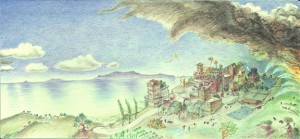An Ecocity Builders email update — March 2011
Fire resistant ecotown sketch by Richard Register
Dear Friends and Supporters,
The on-going disaster in Japan should not pass without a constructive response from us, which is this: ecocity design can help prevent severe earthquake and tsunami damage and can eliminate nuclear disaster completely. Ecocity design could have helped prevent the immense scale of devastation experienced in Japan and in other areas recently hit by natural disaster, like New Orleans, Sri Lanka and Haiti to name a few. If better understood and acted upon, ecocity design can help us create cities that can withstand these kinds of large scale disasters.
Elevated fill and ecocity design
At Sendai, Japan, ecocity design on top of elevated fill would have prevented most of the tsunami’s devastation by keeping the city safely above the floodwaters’ reach. Specifically, compact development built on artificial fill and designed for minimal to zero cars would have made a tremendous difference. Compactness is key here in that the ecocity becomes much more resilient in disasters due to its shape and size (think of the performance of a very large ship in a stormy ocean compared to a little boat). Furthermore, a city of small area relative to the number of people can better afford to rise up above the anticipated worst case flood event. Conversely, the cost of raising up a vast city of sprawl on fill is just not feasible.
Sendai could shrink to 40% the land area it now covers by employing ecocity design. Similarly, the car-dominated areas of New Orleans that were catastrophically damaged in hurricane Katrina could likely shrink down to 15% the current land area to become somewhat more dense and much more interestingly designed, like a French Quarter/streetcar district.

